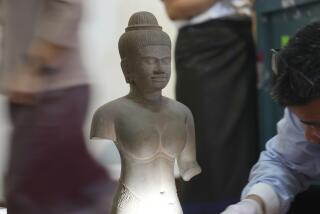Stolen Indian art returned
- Share via
PALM SPRINGS — A collection of rare American Indian artifacts worth up to $160,000 was returned to its owners Friday after an investigation that began three years ago when thieves broke into an Indio museum and spirited the treasures away in garbage bags.
“I have told curators that everyone who comes through the door may not be an art lover,” said Joseph Stuart, a recently retired FBI agent who led the investigation. “Some of those people are looking to steal artifacts.” The items are often sent to Asia and Europe, where Southwestern art is highly prized, he said.
Stuart joined FBI officials and Assistant U.S. Atty. Dennise Willett at a news conference Friday in Palm Springs to discuss the case.
The stolen art included nine intricately carved Zuni and Hopi pots and eight tightly woven reed baskets made by California’s Cahuilla Indians. The items were on loan to the Cabazon Band of Mission Indians Cultural Museum when they were taken in January 2005. Three artifacts are still missing.
The thieves disabled an alarm, broke into a glass case and stuffed the baskets and clay pots into trash bags, investigators said. The FBI sent out fliers urging art dealers to be on the lookout for the items. One of the suspects, Steven Farmer, was arrested after trying to sell the artifacts to an FBI informant, Stuart said.
“He was trying to sell between $140,000 and $160,000 worth of artifacts for $4,000 to feed a methamphetamine addiction,” he said.
Farmer, who agents said is a Riverside County resident in his mid-30s, was sentenced to 41 months in federal prison last December.
FBI officials would not say if they are seeking more suspects but said the case is still pending.
For Jane Andrade, the case is now closed.
“That pottery was given to me by my mother, who got it from her mother,” said the La Quinta woman, who received her lost pottery Friday.
“We loaned it to the museum. When I got the call that everything was stolen, I was surprised. I’d like to know how they got it all out of the museum, transported it around for years and nothing happened to it,” she said.
Andrade has never really known where to put the fragile pottery. She’s kept it on her mantel or in other spots around the house.
“It was difficult when I had a kid and they were throwing a football around,” she said. “I will have to find a proper place for it now.”
The colorfully painted pots are round, squat, fluted and bowl-like. An especially ornate one has a picture of a deer with a spear through its heart. The pots originated in the Arizona, New Mexico and Colorado areas, and the oldest dates to before 1850, Stuart said.
The baskets were all made by California Indians. One belongs to the Agua Caliente tribe of Palm Springs. The others were turned over to the state Department of Parks and Recreation; they will be frozen to kill any bugs or eggs, then placed in a collection in Sacramento.
The theft and trafficking of American Indian artifacts remains a major problem, with a thriving demand for black market pottery, baskets and tools.
Salvador Hernandez, assistant director in charge of the FBI’s Los Angeles office, said the agency maintains a “robust” program tracking stolen art and will continue to investigate. It’s not just stolen art, he said; it’s stolen culture.
After the news conference, officials from Anza Borrego Desert State Park donned white gloves and carefully packed up the Cahuilla baskets.
“These are examples of Native American art that go back hundreds and thousands of years,” said Mark Jorgensen, the park’s superintendent. “We’re thrilled that they don’t appear damaged. So often these things are gone and we lose them forever.”
--
More to Read
Sign up for Essential California
The most important California stories and recommendations in your inbox every morning.
You may occasionally receive promotional content from the Los Angeles Times.












